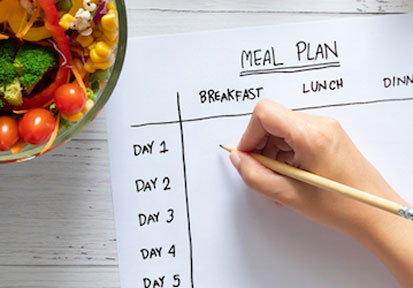With food hype in the media flip-flopping over high carb vs. low carb and high fat vs. low fat, it can be hard to know what is the “right” way to eat. Is it eating like a caveman? Is it giving up carbs to go into ketosis? Or eating only plants? What’s the best way to eat for health or performance? What about when you want to lose weight because your health, promotion, or even career depend on it?
Weight loss sounds simple: Take less “energy in” (fuel from food and drinks, measured in calories) and use more “energy out” (calories burned through daily physical activity and exercise). Your body will burn through the stored energy (fat), and you’ll lose weight. But it isn’t quite that easy, because many other factors are involved in managing your weight; some you can control and others you can’t.
 One factor you can control (most of the time, anyway) is the type and amount of food you eat. Not every eating style is right for you at every time. (See “Pros and cons of popular eating styles” to learn more.) Travel, deployment, and training might limit your ability to choose the foods you want because the available options are limited or you’re on a different schedule. Also, the eating pattern you like might not be appropriate at particular times, such as when the demands of high-intensity training or a mission might mean your weight-loss eating style can result in underfueling, or when injury or health issues have special nutrient demands. Less energy intake (fewer calories) doesn’t always mean less food. Choosing different types of foods or eating patterns also can help you succeed in managing your weight.
One factor you can control (most of the time, anyway) is the type and amount of food you eat. Not every eating style is right for you at every time. (See “Pros and cons of popular eating styles” to learn more.) Travel, deployment, and training might limit your ability to choose the foods you want because the available options are limited or you’re on a different schedule. Also, the eating pattern you like might not be appropriate at particular times, such as when the demands of high-intensity training or a mission might mean your weight-loss eating style can result in underfueling, or when injury or health issues have special nutrient demands. Less energy intake (fewer calories) doesn’t always mean less food. Choosing different types of foods or eating patterns also can help you succeed in managing your weight.
Your eating pattern or style might change depending on changes in your lifestyle, health, or fitness goals. One style might work better for you during intense training or operations (see Eat to fuel your performance), while another might work better during a temporary or transition setting (PCS, deployment), so you might need to adjust. Finding an eating pattern that works might take some trial and error. However, it’s important to consider a variety of nutritional and lifestyle factors to help you choose the eating pattern that best fits:
- Your lifestyle and schedule
- Your tastes and food preferences
- Your unique metabolism
“Unique metabolism” refers to the way your body works, including how you metabolize food and how factors such as your activity level, genetics, and environment impact your nutrient needs. Other factors that affect your individual metabolism—a concept called “biochemical individuality”—are still being discovered.
Basics of a lifelong eating plan
Nutritional considerations
- Eat whole or “true” foods: Choose foods that are minimally processed, close to their original state, or still resemble their original sources.
- Eat mostly plants, such as fruits, vegetables, whole grains, nuts, seeds, and beans.
- Maximize nutrients: Choose foods and beverages packed with naturally occurring nutrients, antioxidants, and phytochemicals.
- Antioxidants are substances that can prevent or delay cell damage.
- Phytochemicals are compounds found in plants that can promote health.
- Avoid empty calories, foods that might fill you up but don’t have much (or any) nutritional value.
- Avoid foods with long lists of ingredients on the Nutrition Facts label.
- Don’t think of macronutrients (carbs, protein, or fat) as “bad.” Just remember some foods are higher in nutritional quality than others.
- Eat enough food to give you the energy (calories) you need to do your job, workouts, home and family responsibilities, etc.).
- Eat so you’re satisfied: an amount and variety of foods that isn’t too restrictive and doesn’t leave you feeling hungry all the time. Don’t cut out all your favorite foods. Allow yourself a variety of foods. No “diet” will last if you feel hungry or too deprived.
- Eat what works for you (not your neighbor, spouse, or workout buddy): foods that make you feel energized and less fatigued, foods that leave you with fewer cravings, and foods that support your health and performance.
Lifestyle considerations
|
Once you choose an eating pattern, pay attention to how your body responds. Allow a few weeks to adjust before you assess whether a new eating pattern is truly working for you. Do you feel energized and satisfied? Are you performing well at work, at home, and in workouts? If the answers are “yes,” then keep going with that eating pattern. If it’s “no,” then reassess what isn’t working for you and adjust. For help, speak with a Registered Dietitian (RD) who can create an individualized eating plan to meet your needs.
Learn more at our “Get into Fighting Weight” guide.
